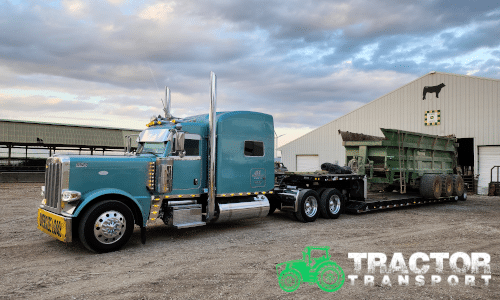
Trusted By All
50K+
Customers
65
Loads
22
Brokers
10+
Years of Experience
The Daily Bale

William Thomas, Author
TractorTransport.com
Antique tractors and farm machinery shipping present a unique set of difficulties. These pieces of equipment are much more than simple tools; they represent the rich cultural legacy and history of agriculture and are extremely emotionally and economically valuable. The importance of safe and secure shipment is increased because older equipment may be more prone to damage during transit. Due to their age and often large and unusual shapes, these instruments need unique handling and shipping methods. Each piece of machinery is a tribute to the development of farming technology; thus, protecting them during transport becomes crucial. This section will delve into the nuances of adequately shipping vintage tractors and agricultural machinery and offer insights into the best procedures to guarantee their protection during travel.
Challenges in Shipping Antique Farm Equipment
Understanding and navigating the particular difficulties involved in transporting antique agricultural machinery is crucial:
- Handling Fragility: Antique equipment might be delicate and more prone to harm because of its age. Extra care must be taken to protect their structural integrity while in transit.
- Dimensional Restrictions: Antique farming equipment frequently has atypical dimensions. The shipping procedure must be adjusted because of these different sizes and shapes.
- Shipping Expenses: Shipping is typically more expensive than shipping conventional agricultural equipment because of the worth of these antiques and the unique attention they require.
- Regulatory Compliance: Specific restrictions and regulations may apply to the transportation of vintage equipment, and these must be rigorously followed.
- Concerns With Insurance: Keeping these priceless items adequately insured during their voyage can be difficult.
Your priceless antiques can arrive at their destination safely and securely if you recognize and overcome these obstacles.

Safety Precautions for Loading Antique Farm Equipment
Special care focused on loading antique farm equipment is necessary to reduce the difficulties of shipping ancient farm equipment. These serve two purposes: protecting the equipment and adhering to transportation laws and regulations.
- Custom Crating: Because of the fragile nature of the equipment and its unusual size, custom-built crates should be used. To cushion against impacts during transit, these packages should be wrapped in bubble wrap or foam.
- Sealing & Wrapping: Protect the equipment from dirt, moisture, and other harmful environmental elements by wrapping it in industrial-grade plastic and sealing it with it.
- Secure Attachment: The equipment should be firmly fastened within the crate to prevent movement and potential damage while transporting.
- Labeling: It’s crucial to include labels that are both clear and indicate the crate’s orientation (top, bottom, side), as well as how delicate it is. This will instruct those using the device to handle it appropriately.
- Weatherproof Packaging: Consider using weatherproof packaging materials if the trip is exposed to inclement weather.
These safety measures can help preserve and protect the antique machinery from regular shipping threats. Additional precautions should be taken to ensure the equipment is adequately secured and covered while in transit.
Safety Precautions For Transporting Antique Farm Equipment
It’s essential to use a delicate approach when loading and unloading vintage farm equipment for transportation. Numerous measures can be taken to prevent equipment damage during these procedures.
- Professional Handling: Employ qualified experts who know the fragility of old agricultural machinery and are familiar with managing such goods.
- Use of Equipment: To minimize physical handling during the loading and unloading, use specialized equipment like forklifts and hand trucks.
- Layered Protection: Layers of protection, such as bubble wrap or foam sheets, can cushion the equipment during movement associated with loading and unloading.
- Slow and Steady: Taking your time when loading and unloading cargo is crucial. Rushing often results in mishaps or damage.
- Comprehensive Directions: Make sure everyone helping with the loading and unloading procedure understands the delicate nature of the equipment by giving them clear instructions.
These safety measures may help ensure that the old agricultural machinery is transported in good condition. They provide a thorough strategy for securing these priceless artifacts in transit and work in conjunction with the loading procedures mentioned earlier.
Vintage farm equipment transportation requires a particular method to secure its safe delivery and keep its inherent worth. These antique objects must be handled with care, packaged meticulously, and transported using techniques that have been well thought out. The safe and successful transportation of such priceless goods depends on hiring qualified personnel, using the proper handling tools, and applying protective layers. Every safety measure adopted protects these priceless artifacts’ historical and cultural significance and physical integrity. This demonstrates the critical need for specialist transportation for old farm machinery, which ensures that the equipment arrives at its destination in the same condition as when it set out on its voyage.